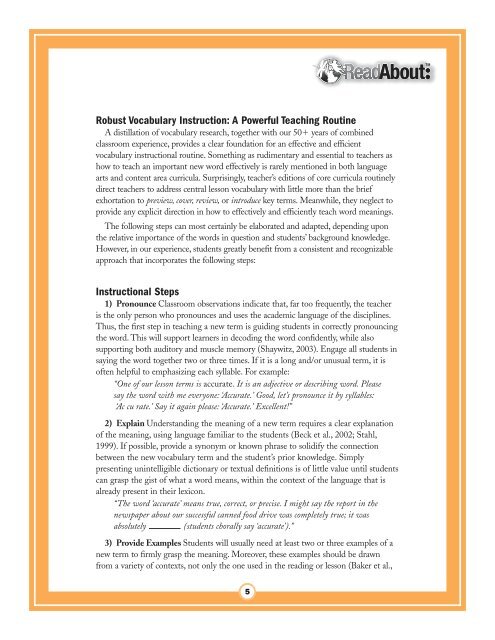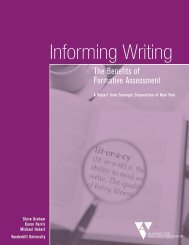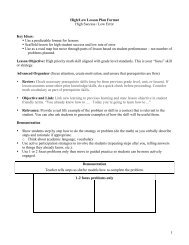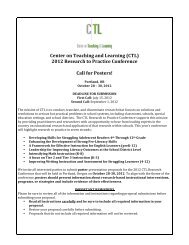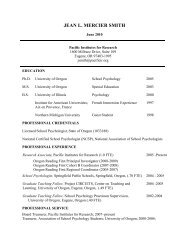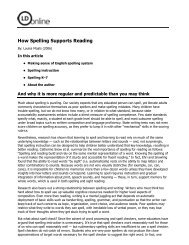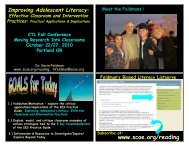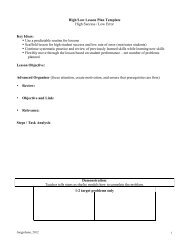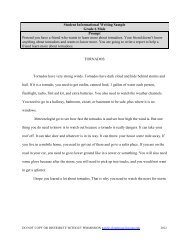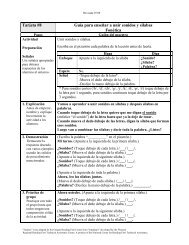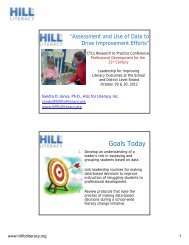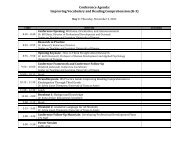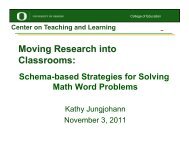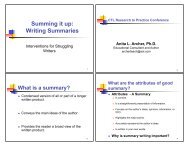Narrowing the Language Gap: - Center on Teaching and Learning ...
Narrowing the Language Gap: - Center on Teaching and Learning ...
Narrowing the Language Gap: - Center on Teaching and Learning ...
- No tags were found...
You also want an ePaper? Increase the reach of your titles
YUMPU automatically turns print PDFs into web optimized ePapers that Google loves.
TMRobust Vocabulary Instructi<strong>on</strong>: A Powerful <strong>Teaching</strong> RoutineA distillati<strong>on</strong> of vocabulary research, toge<str<strong>on</strong>g>the</str<strong>on</strong>g>r with our 50 years of combinedclassroom experience, provides a clear foundati<strong>on</strong> for an effective <strong>and</strong> efficientvocabulary instructi<strong>on</strong>al routine. Something as rudimentary <strong>and</strong> essential to teachers ashow to teach an important new word effectively is rarely menti<strong>on</strong>ed in both languagearts <strong>and</strong> c<strong>on</strong>tent area curricula. Surprisingly, teacher’s editi<strong>on</strong>s of core curricula routinelydirect teachers to address central less<strong>on</strong> vocabulary with little more than <str<strong>on</strong>g>the</str<strong>on</strong>g> briefexhortati<strong>on</strong> to preview, cover, review, or introduce key terms. Meanwhile, <str<strong>on</strong>g>the</str<strong>on</strong>g>y neglect toprovide any explicit directi<strong>on</strong> in how to effectively <strong>and</strong> efficiently teach word meanings.The following steps can most certainly be elaborated <strong>and</strong> adapted, depending up<strong>on</strong><str<strong>on</strong>g>the</str<strong>on</strong>g> relative importance of <str<strong>on</strong>g>the</str<strong>on</strong>g> words in questi<strong>on</strong> <strong>and</strong> students’ background knowledge.However, in our experience, students greatly benefit from a c<strong>on</strong>sistent <strong>and</strong> recognizableapproach that incorporates <str<strong>on</strong>g>the</str<strong>on</strong>g> following steps:Instructi<strong>on</strong>al Steps1) Pr<strong>on</strong>ounce Classroom observati<strong>on</strong>s indicate that, far too frequently, <str<strong>on</strong>g>the</str<strong>on</strong>g> teacheris <str<strong>on</strong>g>the</str<strong>on</strong>g> <strong>on</strong>ly pers<strong>on</strong> who pr<strong>on</strong>ounces <strong>and</strong> uses <str<strong>on</strong>g>the</str<strong>on</strong>g> academic language of <str<strong>on</strong>g>the</str<strong>on</strong>g> disciplines.Thus, <str<strong>on</strong>g>the</str<strong>on</strong>g> first step in teaching a new term is guiding students in correctly pr<strong>on</strong>ouncing<str<strong>on</strong>g>the</str<strong>on</strong>g> word. This will support learners in decoding <str<strong>on</strong>g>the</str<strong>on</strong>g> word c<strong>on</strong>fidently, while alsosupporting both auditory <strong>and</strong> muscle memory (Shaywitz, 2003). Engage all students insaying <str<strong>on</strong>g>the</str<strong>on</strong>g> word toge<str<strong>on</strong>g>the</str<strong>on</strong>g>r two or three times. If it is a l<strong>on</strong>g <strong>and</strong>/or unusual term, it isoften helpful to emphasizing each syllable. For example:“One of our less<strong>on</strong> terms is accurate. It is an adjective or describing word. Pleasesay <str<strong>on</strong>g>the</str<strong>on</strong>g> word with me every<strong>on</strong>e: ‘Accurate.’ Good, let’s pr<strong>on</strong>ounce it by syllables:‘Ac cu rate.’ Say it again please: ‘Accurate.’ Excellent!”2) Explain Underst<strong>and</strong>ing <str<strong>on</strong>g>the</str<strong>on</strong>g> meaning of a new term requires a clear explanati<strong>on</strong>of <str<strong>on</strong>g>the</str<strong>on</strong>g> meaning, using language familiar to <str<strong>on</strong>g>the</str<strong>on</strong>g> students (Beck et al., 2002; Stahl,1999). If possible, provide a syn<strong>on</strong>ym or known phrase to solidify <str<strong>on</strong>g>the</str<strong>on</strong>g> c<strong>on</strong>necti<strong>on</strong>between <str<strong>on</strong>g>the</str<strong>on</strong>g> new vocabulary term <strong>and</strong> <str<strong>on</strong>g>the</str<strong>on</strong>g> student’s prior knowledge. Simplypresenting unintelligible dicti<strong>on</strong>ary or textual definiti<strong>on</strong>s is of little value until studentscan grasp <str<strong>on</strong>g>the</str<strong>on</strong>g> gist of what a word means, within <str<strong>on</strong>g>the</str<strong>on</strong>g> c<strong>on</strong>text of <str<strong>on</strong>g>the</str<strong>on</strong>g> language that isalready present in <str<strong>on</strong>g>the</str<strong>on</strong>g>ir lexic<strong>on</strong>.“The word ‘accurate’ means true, correct, or precise. I might say <str<strong>on</strong>g>the</str<strong>on</strong>g> report in <str<strong>on</strong>g>the</str<strong>on</strong>g>newspaper about our successful canned food drive was completely true; it wasabsolutely (students chorally say ‘accurate’).”3) Provide Examples Students will usually need at least two or three examples of anew term to firmly grasp <str<strong>on</strong>g>the</str<strong>on</strong>g> meaning. Moreover, <str<strong>on</strong>g>the</str<strong>on</strong>g>se examples should be drawnfrom a variety of c<strong>on</strong>texts, not <strong>on</strong>ly <str<strong>on</strong>g>the</str<strong>on</strong>g> <strong>on</strong>e used in <str<strong>on</strong>g>the</str<strong>on</strong>g> reading or less<strong>on</strong> (Baker et al.,5


